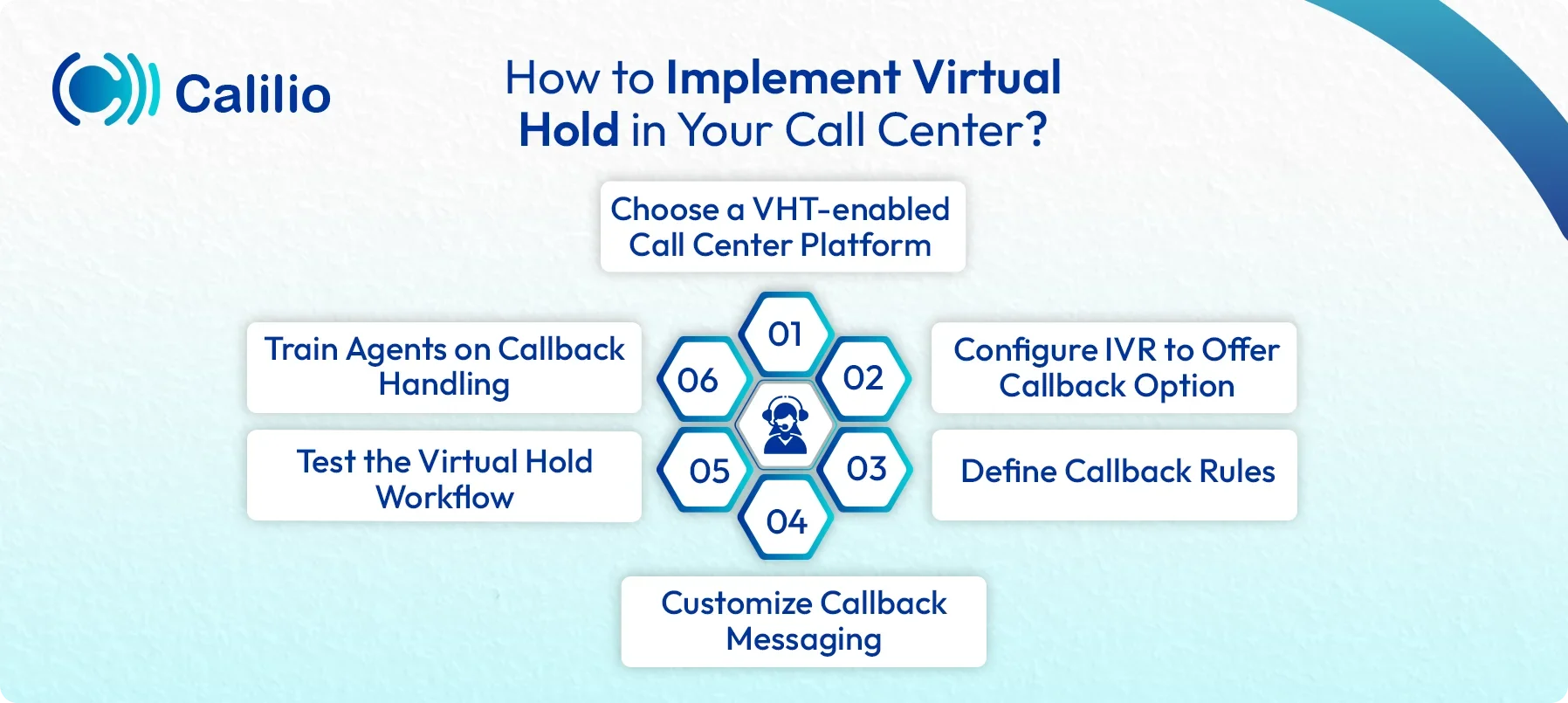What is a Virtual Hold? Key Features, Benefits & Setup Tips

Imagine calling a company for support and hearing, “Your call is important to us. Please stay on the line.” Minutes pass, and you’re still waiting—frustration builds, and you’re tempted to hang up before anyone answers.
That’s exactly the kind of experience virtual hold technology is designed to prevent. Instead of forcing customers to wait endlessly, it allows them to reserve their place in the queue and receive a callback when an agent becomes available.
In this article, we’ll explore what a virtual hold callback is, how it works, and why it’s one of the most effective tools for improving customer satisfaction and call center performance.
Key Highlights:
Virtual hold eliminates long on-hold times by allowing callers to book their place in the queue and receive an automatic callback when an agent becomes available.
It improves customer satisfaction by reducing frustration, enhancing flexibility, and valuing customers’ time.
Virtual hold technology uses ACD, IVR, and smart queue management to estimate wait times, schedule callbacks, and connect callers seamlessly to agents.
Businesses benefit from reduced call abandonment, higher agent productivity, and better first-call resolution (FCR) thanks to virtual hold.
The virtual hold feature automates callback scheduling, manages call queues efficiently, and ensures every customer gets timely support without waiting on hold.
What is Virtual Hold Technology?
Virtual Hold Technology (VHT) is an advanced queue management solution that allows callers to reserve their place in the queue without staying on hold. Instead of waiting on the line, callers can hang up and receive a callback from an agent when it's their turn.
When the call queue is full, the system informs the caller about the estimated wait time and asks if they’d prefer a callback. Once they confirm, the system saves their place in line and calls them back automatically when an agent becomes available.
This feature makes the customer experience smoother, as no one likes waiting endlessly on the phone. With virtual hold, customers can go about their day while still keeping their turn in line.
How Does Virtual Hold Callback Work?
Virtual hold callback works by placing the customer call in the queue virtually and calling them back to their provided number when it’s their turn.
Behind the scenes, a virtual hold system uses smart call routing and queue management to keep callers in line, even when they hang up. It’s a mix of Automated Call Distribution (ACD), Interactive Voice Response (IVR), and callback scheduling technology working together.
- Call Enters the Queue: When a customer calls, the system checks if agents are available. If all agents are busy, the call is placed in a queue.
- Wait Time Estimation: The system calculates the estimated wait time based on current queue length, average handling time, and agent availability.
- Callback Option Offered: Instead of keeping the caller on hold, the IVR system offers an option like, “Press 1 to receive a callback.” The caller can either confirm their existing number or enter a different one.
- Virtual Queue Reservation: Once confirmed, the system reserves their place in the queue. The caller continues to move up the queue virtually.
- Callback Triggered Automatically: When their turn arrives, the system automatically initiates an outbound call to the customer and connects them to the next available agent.
What are the Key Features of Virtual Hold Technology?
Virtual hold technology usually includes features such as callback options, real-time wait time updates, smart queue management, call routing, CRM integration, multichannel support, and detailed performance analytics.

1. Callback Option
Virtual hold technology lets callers request a callback instead of waiting on hold. This reduces frustration, prevents call abandonment, and improves customer satisfaction by allowing them to continue their tasks while waiting for the agent’s call.
2. Estimated Wait Time (EWT)
It provides real-time updates on how long the customer will wait before speaking to an agent. Sharing accurate wait times helps set clear expectations and builds trust with callers.
3. Smart Queue Management
The system manages queues intelligently by prioritizing calls based on urgency, customer value, or issue type. This ensures high-value customers or critical issues are handled first, improving service efficiency.
4. Seamless Call Routing
Once an agent is available, the technology automatically connects the right customer to the right agent or department. This ensures faster resolution.
5. CRM Integration
Virtual hold technology can be integrated with CRM systems. It helps agents access customer profiles and interaction history before the call starts. This enables personalized communication and quicker problem-solving.
6. Multichannel Support
Virtual hold technology works across multiple platforms, phone, web, and mobile apps. Whether a customer requests a callback online or through voice, the experience remains consistent.
7. Analytics and Reporting
It provides detailed reports on callback success rates, agent performance, and customer satisfaction. These insights help businesses identify bottlenecks and improve overall contact center operations.
What are the Benefits of Using Virtual Hold Technology in Your Business?
Virtual hold reduces customer wait times, lowers call abandonment rates, boosts agent productivity, and enhances first-call resolution by providing a smoother call experience.
1. Reduces Customer Wait Time
Virtual hold allows customers to request a callback instead of waiting in long queues. For example, during high-demand periods like product launches or billing cycles, customers can schedule a convenient callback and avoid long on-hold times. This makes the process smoother and keeps them engaged without frustration.
2. Improves Customer Experience
Virtual hold technology enhances customer experience by eliminating the frustration of long hold times. Customers can continue their daily work while the system holds their place in line. It shows that businesses respect customers’ time, leading to higher satisfaction.
3. Increases Agent Efficiency
In a busy support center, virtual hold technology helps agents focus on one customer at a time instead of juggling multiple waiting calls. As a result, they can deliver better service and handle more calls effectively throughout the day.
4. Lowers Call Abandonment Rates
Many customers hang up when hold times are too long. Virtual hold minimizes this by ensuring customers don’t need to stay on the line. This significantly reduces the chances of them hanging up out of frustration. This ultimately helps avoid potential opportunity loss.
5. Optimizes Call Center Operations
The system helps distribute call volumes evenly, especially during peak hours. For instance, if a retail call center experiences high traffic during sales events, Virtual hold automatically schedules callbacks during less busy times, keeping operations balanced and efficient.
6. Enhances First-call Resolution (FCR)
With CRM integration, agents can access customer data before calling back. A bank agent, for example, can review a client’s transaction history before returning the call, helping resolve issues faster and in one go.
7. Boosts Overall Business Efficiency
Virtual hold technology improves operational efficiency by reducing telecom costs associated with long hold times. It also helps businesses maintain a consistent service experience across multiple channels like voice, web, or mobile. It helps in strengthening brand reliability and building customer trust.
Virtual Hold vs. Traditional Hold: Key Differences
Traditional hold keeps callers waiting on the line, often leading to frustration and call abandonment. In contrast, virtual hold allows callers to retain their place in the queue and receive a callback when an agent is available, reducing wait time and improving overall satisfaction.
Here’s how they differ in different aspects:
Aspect | Virtual Hold | Traditional Hold |
Waiting Experience | Customers request a callback and hang up, continuing other tasks while keeping their spot in the queue. | Customers stay on the line listening to hold music or announcements until an agent answers. |
Call Abandonment | Greatly reduces call abandonment since customers don’t need to wait on the line. | Higher abandonment rates due to long or uncertain waiting times. |
Customer Satisfaction | Enhances satisfaction by offering flexibility and valuing customers’ time. | Low satisfaction caused by frustration and wasted time. |
Agent Productivity | Agents handle calls efficiently as they connect only when customers are ready. | Agents may rush calls to reduce queue length, lowering quality. |
Cost Efficiency | Frees up phone lines, reduces telephony costs, and optimizes resources. | Keeps lines busy during wait time, increasing telecom costs. |
System Load | Balances call volume effectively, even during peak hours. | Overloads the system during high-traffic periods. |
Use Case Example | During peak hours, callers can schedule callbacks, avoiding long queues and improving their experience. | During peak hours, all customers wait on hold, leading to congestion and frustration. |
How to Implement Virtual Hold in Your Call Center?
To implement virtual hold in your call center, start by selecting a call center software that supports callback functionality. Then, configure your IVR system to offer the virtual hold option, set callback rules and scheduling preferences, and train your agents to manage callbacks efficiently.

- Choose a VHT-enabled Call Center Platform
Select a solution that offers built-in virtual hold or integrates easily with third-party VHT providers. - Configure IVR to Offer Callback Option
Set up your IVR system to present the callback option during high-traffic periods or long queue times. - Define Callback Rules
Decide when callbacks should be offered (e.g., after a specific wait time) and how they will be prioritized. - Customize Callback Messaging
Create clear, professional prompts that explain the callback option and set expectations for response time. - Test the Virtual Hold Workflow
Run test calls to ensure the callback feature works seamlessly and callers are properly queued. - Train Agents on Callback Handling
Provide training to help agents manage scheduled callbacks effectively and maintain service quality.
Conclusion
Virtual hold isn't just a convenience, but a smarter way to manage customer calls. Instead of keeping callers stuck on hold, it gives them control over their time while ensuring they don’t lose their place in line. This simple yet powerful feature improves customer satisfaction, reduces frustration, and boosts your call center’s efficiency.
By integrating virtual hold technology, your business can handle peak hours smoothly, cut down abandonment rates, and empower agents to deliver faster, more focused service.

Get Cashbacks Up to 43% Straight To Your Wallet!
Unlimited Virtual Numbers – Local, Mobile & Toll-Free from 100+ Countries
Free Local Phone Number from US or Canada
Crystal-Clear Calls Starting at Just $0.0153/min
24/7 Human Support – Because Great Service Never Takes a Holiday


Frequently Asked Questions
Does virtual hold work for both inbound and outbound calls?
Virtual hold is primarily designed for inbound calls, allowing callers to request a callback instead of waiting on hold. However, some advanced systems also support outbound callback scheduling, where agents can follow up with customers at a preferred time, making it useful in both inbound and proactive outbound scenarios.
How does virtual hold improve customer experience?

Still have questions?
Can’t find the answer you’re looking for? Please chat with our friendly team.
Stay in the loop
Get the latest call insights, trends, and updates delivered straight to your inbox.
By subscribing, you agree to receive updates from Calilio.
You can unsubscribe anytime.